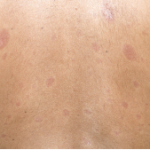
SAN DIEGO—Recent updates to the classification criteria for systemic sclerosis (SSc) and a better understanding of autoimmunity’s role in the disease are helping investigators unravel its mysteries, said Richard Silver, MD, director of the division of rheumatology and immunology at the Medical University of South Carolina in Charleston.
Dr. Silver updated rheumatologists on SSc research at the 2013 ACR/ARHP Annual Meeting, held October 26–30. [Editor’s Note: This session was recorded and is available via ACR SessionSelect at www.rheumatology.org.] Dr. Silver addressed some of the challenges of diagnosing SSc, highlighting diseases that may mimic scleroderma, serious potential complications, and new clinical trials that may help extend patients’ lives.
There are three key components involved in SSc: autoimmunity, vasculopathy, and fibrosis, Dr. Silver said. “How these three major facets interact with each other remains the biggest challenge for investigators,” he said.
Distinguish From Mimics
A challenge for a rheumatologist whose patient presents with symptoms that may initially appear to be caused by SSc is that the disease often mimics others, a set of skin conditions known as “pseudoscleroderma,” Dr. Silver said. Hardening of the skin doesn’t always mean scleroderma, so serologic testing for specific autoantibodies or nailfold capillary microscopy can help confirm diagnosis. Common pseudoscleroderma conditions include diffuse fasciitis with eosinophilia (DFE), scleredema, scleromyxedema, and environmental pseudosclerodermas such as eosinophilia myalgia syndrome, among others.
Examining the character of skin tautness and then the distribution of the skin involvement can aid in diagnosis, Dr. Silver said. “In many of these pseudoscleroderma conditions, the process involves more than the dermis. It goes deeper, to the subdermis and the fascia, resulting in a woody induration of the skin,” he said. “Many of these mimics also spare the fingers and sometimes the face, while scleroderma typically affects the fingers, hands, and face.” In most pseudosclerodermas, there is no Raynaud’s phenomenon, and antinuclear antibodies also are rarely present in these mimicking conditions while common in scleroderma, he noted. Other important distinguishing features may be organ involvement, particularly the heart or lungs, which is usually absent in the various pseudoscleroderma conditions.
In DFE, a full-thickness skin biopsy is needed to confirm diagnosis, he added. The skin involvement extends from the dermis all the way to the fascia and sometimes the muscles, in these cases. Dr. Silver described a patient with DFE who couldn’t grip a football due to tethering of the tendons to the forearms from fibrosis. DFE is almost always steroid responsive, he added, unlike scleroderma.
Nephrogenic systemic fibrosis (NSF), first identified in 1997, is a rare but potentially lethal condition to consider and is related to exposure to gadolinium-based contrast agents in patients with renal failure. A patient with NSF may present with hyperpigmentation and a “woody” induration with significant skin involvement on the forearms and legs, he said. On a skin histopathology section, Dr. Silver pointed out noticeable differences in collagen bundles, including clefts between them that distinguish NSF from SSc. NSF’s prognosis is poor—the fibrosis and calcinosis can affect the heart, lung, diaphragm, and other organs, and it can lead to death, he said. If magnetic resonance imaging is needed for renal disease patients, “gadolinium-based contrast agents should be given at the lowest possible dose.”
Updated Criteria
The 1980 SSc classification criteria were recently updated by the ACR and the European League Against Rheumatism and published last November.1 Achieving a score of nine or higher is required for a definitive diagnosis of SSc. Definitive diagnosis may be made if there is skin thickening to the fingers of both hands extending proximal to the metacarpophalangeal joints. However, a combination of other symptoms can also achieve a score of nine without that, including telangiectasia, Raynaud’s phenomenon, positive tests for particular autoantibodies, and abnormal nailfold capillaries.
“We classify patients based on their skin involvement, on the basis of certain vascular features, as well as certain autoantibodies,” Dr. Silver said. If the patient has Raynaud’s phenomenon, susceptibility to cold may be more important than having tricolor involvement to indicate possible SSc, he added. “If you require one color, you are overdiagnosing, but if you require all three, you’re underdiagnosing Raynaud’s phenomenon,” he said. Nailfold capillary examination is a very useful method of distinguishing patients who have primary Raynaud’s phenomenon from those patients who have or are at risk of developing SSc, Dr. Silver said.
Autoantibodies that may indicate SSc are anti-Topo1, anti-RNA Poly III, and anticentromere, and are associated with particular subsets of disease and risks for complications, he added. Complications of SSc may include organ involvement, and rheumatologists should be aware of this possibility even early in the disease process, Dr. Silver said. “I feel that heart disease is an underrecognized complication of patients with diffuse cutaneous disease,” he added.
Dangerous Complications
Digital ulcers appear frequently and early in SSc patients, Dr. Silver noted. These ulcers are extremely painful and difficult to treat and heal, requiring aggressive therapy with vasodilators, although these are not always available in the United States, he said.
Gastrointestinal disease is second only to skin involvement in SSc, and problems can occur anywhere on the gastrointestinal tract from the mouth to the anus, Dr. Silver said. Quality of life is a serious concern for SSc patients with conditions like gastric antral vascular ectasia, or “watermelon stomach,” he added. “We need better treatments,” but some existing therapies include proton-pump inhibitors for gastroesophageal reflux disease and antibiotics and motility agents for bacterial growth, he noted.
Pulmonary manifestations are another life-threatening possibility in SSc, with lung disease being the most common cause of death in these patients, Dr. Silver said. Watch and test for interstitial lung disease and pulmonary arterial hypertension (PAH), he said. “Pulmonary function tests should be done in all new scleroderma patients, and I would recommend that they be done at baseline and annually,” he said. An isolated decrease in DLCO is an early predictor of PAH and may occur 10 years or more before a diagnosis, he added.
Treatment options for SSc patients with PAH include combinations of anticoagulants, diuretics, oxygen, and digoxin, but these may not always be feasible. The EARLY trial (Endothelin Antagonist Trial in Mildly Symptomatic Pulmonary Arterial Hypertension) of bosentan may offer new hope for SSc patients who have mild PAH, he said. Other possible PAH therapies are the newly approved riociguat and macitentan, as well as selexipag, which is still in trials, “so the armaments to treat PAH are increasing,” Dr. Silver said.
Newer therapies for SSc include immunosuppressive agents and stem-cell therapy, Dr. Silver said. Although he was “a little bit pessimistic about cytokine-blocking therapy,” he spoke about the potential efficacy of stem-cell therapy. While it has a treatment-related mortality of about 5% to 10%, there is dramatic improvement in skin score and thickening. Use caution with patients who have heart disease, he advised.
While new classification criteria will increase the sensitivity and specificity of diagnosis, understanding the molecular events leading to fibrosis in SSc may one day lead to more effective treatments for this disease, Dr. Silver concluded.
Susan Bernstein is a writer based in Atlanta.
